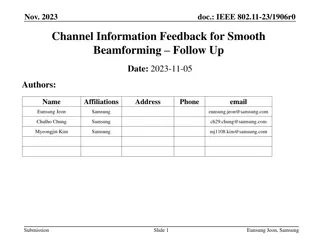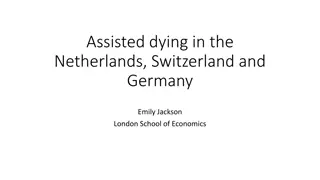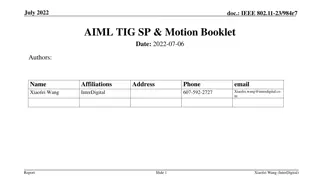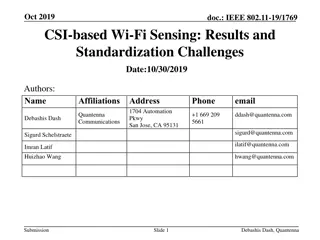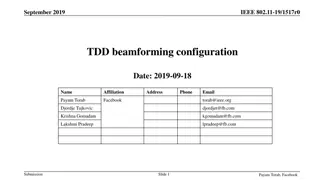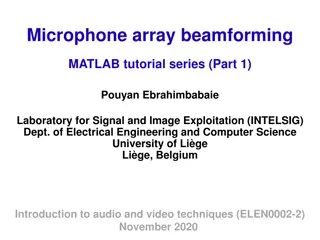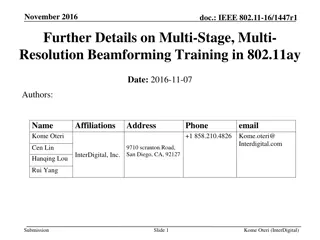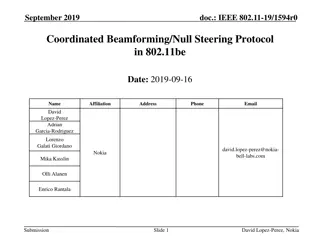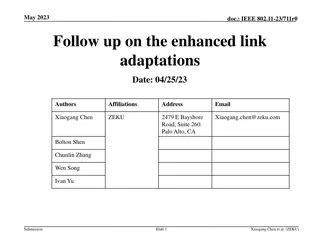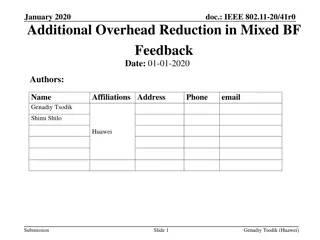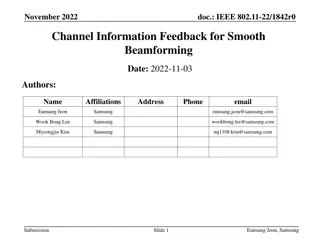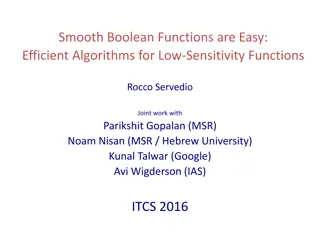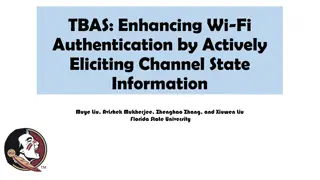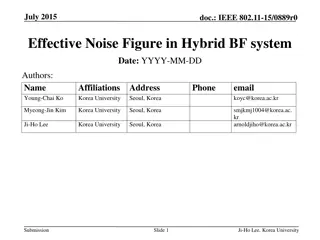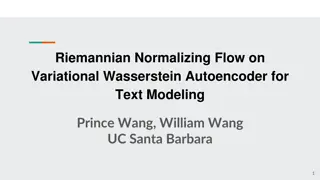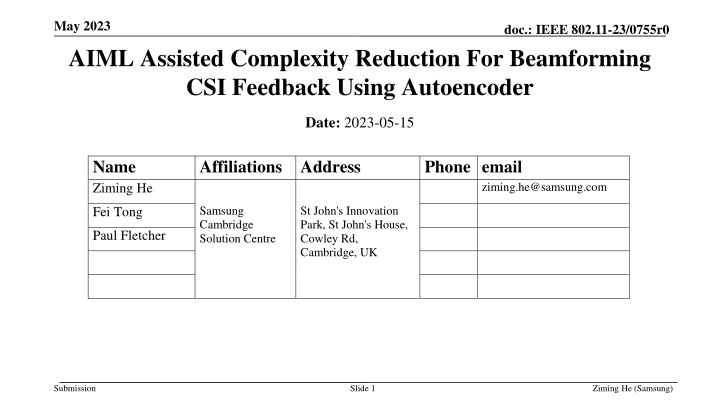
Complexity Reduction in Beamforming CSI Feedback Using Autoencoder
Explore how autoencoder-based schemes can reduce complexity in beamforming CSI feedback, comparing legacy and existing AIML beamforming schemes. Learn about the proposed autoencoder-based scheme's advantages and considered system parameters for performance evaluations in IEEE 802.11-23/0755r0 document by Ziming He from Samsung.
Download Presentation

Please find below an Image/Link to download the presentation.
The content on the website is provided AS IS for your information and personal use only. It may not be sold, licensed, or shared on other websites without obtaining consent from the author. If you encounter any issues during the download, it is possible that the publisher has removed the file from their server.
You are allowed to download the files provided on this website for personal or commercial use, subject to the condition that they are used lawfully. All files are the property of their respective owners.
The content on the website is provided AS IS for your information and personal use only. It may not be sold, licensed, or shared on other websites without obtaining consent from the author.
E N D
Presentation Transcript
May 2023 AIML Assisted Complexity Reduction For Beamforming CSI Feedback Using Autoencoder doc.: IEEE 802.11-23/0755r0 Date: 2023-05-15 Name Ziming He Affiliations Address Samsung Cambridge Solution Centre Phone email ziming.he@samsung.com St John's Innovation Park, St John's House, Cowley Rd, Cambridge, UK Fei Tong Paul Fletcher Submission Slide 1 Ziming He (Samsung)
May 2023 doc.: IEEE 802.11-23/0755r0 Recap: Legacy beamforming scheme Submission Slide 2 Ziming He (Samsung)
May 2023 doc.: IEEE 802.11-23/0755r0 Recap: Existing AIML Beamforming schemes K-means based schemes (e.g., [1]-[2]) The scheme feedbacks an index which represents a codeword in a pre-trained codebook The codebook design in [1] is in angles obtained from V matrix The codebook design in [2] is in either angles (scheme I) or steering matrix (scheme II) Autoencoder based schemes (e.g., [3]-[4]) Neural network is used to compress feedback information In [3], angles are compressed, and the feedforward neural network (FNN) is used for autoencoder In [4], convolutional neural network (CNN) or transformer is used for autoencoder Submission Slide 3 Ziming He (Samsung)
May 2023 doc.: IEEE 802.11-23/0755r0 Proposed autoencoder-based scheme Parameters Nae and NQ need to be optimized to trade-off between model precision and feedback overhead CSI feedback at beamformee Advantages: 1. Steering matrix is compressed directly to avoid angle computation using Givens rotation 2. FNN is used in the encoder to reduce computational complexity Submission Slide 4 Ziming He (Samsung)
May 2023 doc.: IEEE 802.11-23/0755r0 Considered system parameters for performance evaluations Parameters Packet format BW Channel Model Subcarrier Grouping (Ng) Number of feedback subcarriers Number of bits to compress (Nb) Number of Antennas at BFer (Nr) Number of Antennas at BFee (Nc) Number of angles for or (Nh) Number of Spatial Streams NDPA duration NDP duration SIFS duration Values 11ax 20 (MHz) 802.11 Channel-D 4 64 4 (bits) 8 2 13 2 28 (?s) 168 (?s) 16 (?s) Submission Slide 5 Ziming He (Samsung)
May 2023 doc.: IEEE 802.11-23/0755r0 Goodput evaluation method Goodput definition: Goodput definition: ??????(1 ??? ) , ? = where ? = ????+ ????, ????? denotes the MPDU size of beamfored data transmission, ???? the duration used for a model update, ??? the duration of a beamforming cycle. MCS for both BFed data transmission and CSI reports are selected according to mean SNR Model sharing uses legacy beamforming ? The AIML model is updated once within a period of ? containing ? beamforming cycles. A beamforming cycle Submission Slide 6 Ziming He (Samsung)
May 2023 doc.: IEEE 802.11-23/0755r0 Goodput comparison For the proposed scheme, the format of the output from the encoder is half- precision floating-point (16 bits) ????? = 1KB Submission Slide 7 Ziming He (Samsung)
May 2023 doc.: IEEE 802.11-23/0755r0 PER performance comparison MCS8 MCS11 MCS10 MCS4 MCS7 ????? = 1KB Submission Slide 8 Ziming He (Samsung)
May 2023 doc.: IEEE 802.11-23/0755r0 Comparisons of overhead and complexity for CSI reports Scheme Communication overhead per CSI report (bits) 8320 (130 per subcarrier) Number of required multiplications per CSI report 225K Legacy scheme K-means scheme in [1] 704 (11 per subcarrier) 768 (12 per subcarrier) 1024 (16 per subcarrier) 3633K (11 per subcarrier) 7041K (12 per subcarrier) 109277K (16 per subcarrier) 3932K (11 per subcarrier) 7864K (12 per subcarrier) 125829K (16 per subcarrier) 86K (???= 8) 96K (???= 16) K-means scheme II in [2] Proposed autoencoder scheme 3840 (60 per subcarrier, ???= 8) 7680 (120 per subcarrier, ???= 16) Note: complexity of k-mean schemes mainly comes from codeword index searching (Euclidean distance as the metric); complexity of the legacy scheme comes from angle computation (Givens rotation) Submission Slide 9 Ziming He (Samsung)
May 2023 doc.: IEEE 802.11-23/0755r0 Summary We have presented a beamforming CSI feedback scheme with low computational complexity, the key purpose is to enable faster feedback and lower power consumption at non-AP STAs (e.g., mobile devices). This is different from the existing use case in [5] whose main purpose is CSI compression and goodput improvement. Submission Slide 10 Ziming He (Samsung)
May 2023 doc.: IEEE 802.11-23/0755r0 Question Do you agree that Complexity reduction for CSI feedback should be considered as a separate use case for AIML TIG? Submission Slide 11 Ziming He (Samsung)
May 2023 doc.: IEEE 802.11-23/0755r0 References [1] M. Deshmukh, Z. Lin, et al., Intelligent Feedback Overhead Reduction (iFOR) in Wi-Fi 7 and Beyond, IEEE Vehicular Technology Conference (VTC), Jun. 2022 [2] 11-23/0275r1, Improved AIML Enabled Index Based Beamforming CSI Feedback Schemes [3] P. Sangdeh, H. Pirayesh, A. Mobiny and H. Zeng, LB-SciFi: Online Learning-Based Channel Feedback for MU-MIMO in Wireless LANs, 2020 IEEE 28th International Conference on Network Protocols (ICNP), Oct. 2020. [4] 11-23/0290r1, Study on AI CSI Compression [5] 11-22/1934r5, Proposed IEEE 802.11 AIML TIG Technical Report Text for the CSI Compression Use Case Submission Slide 12 Ziming He (Samsung)


